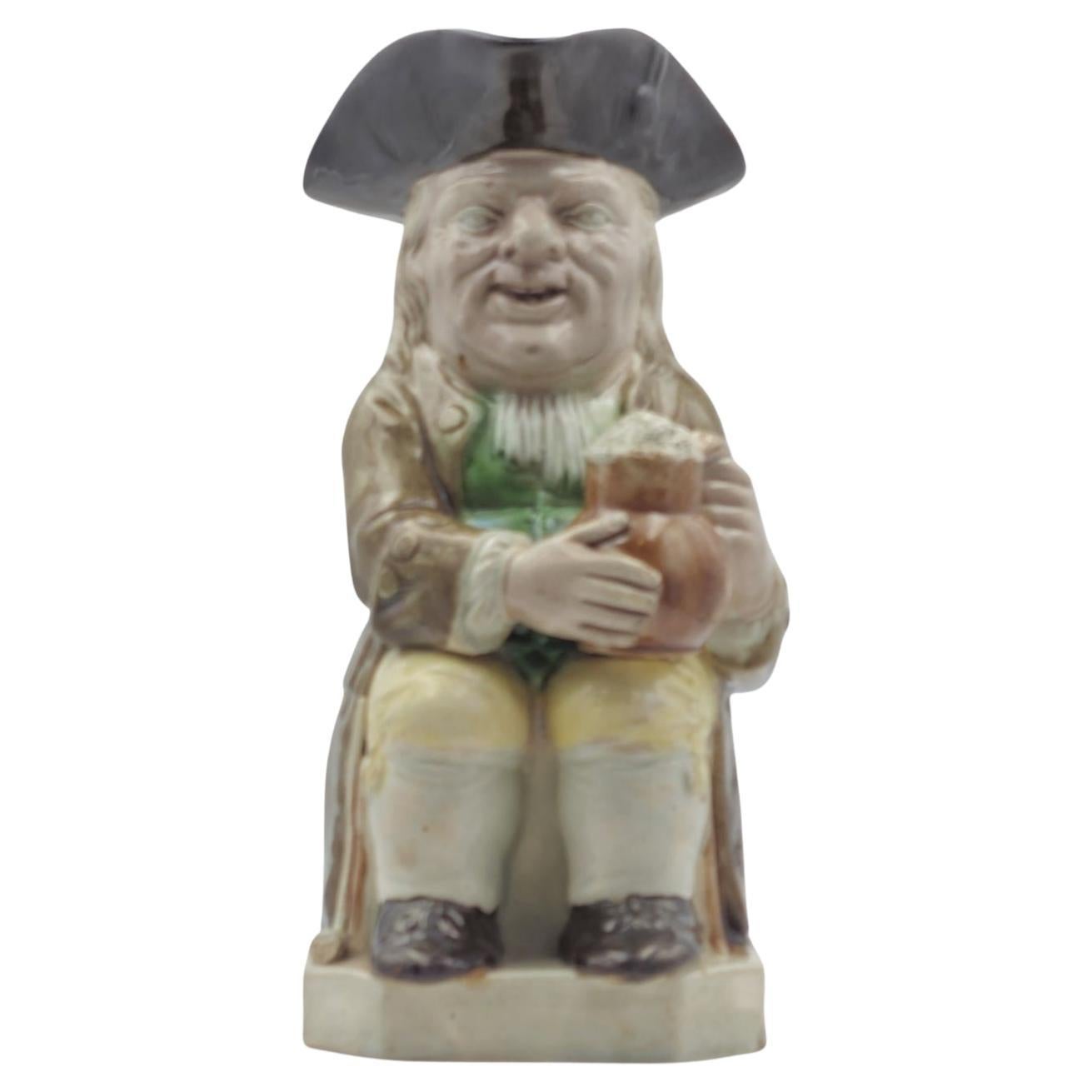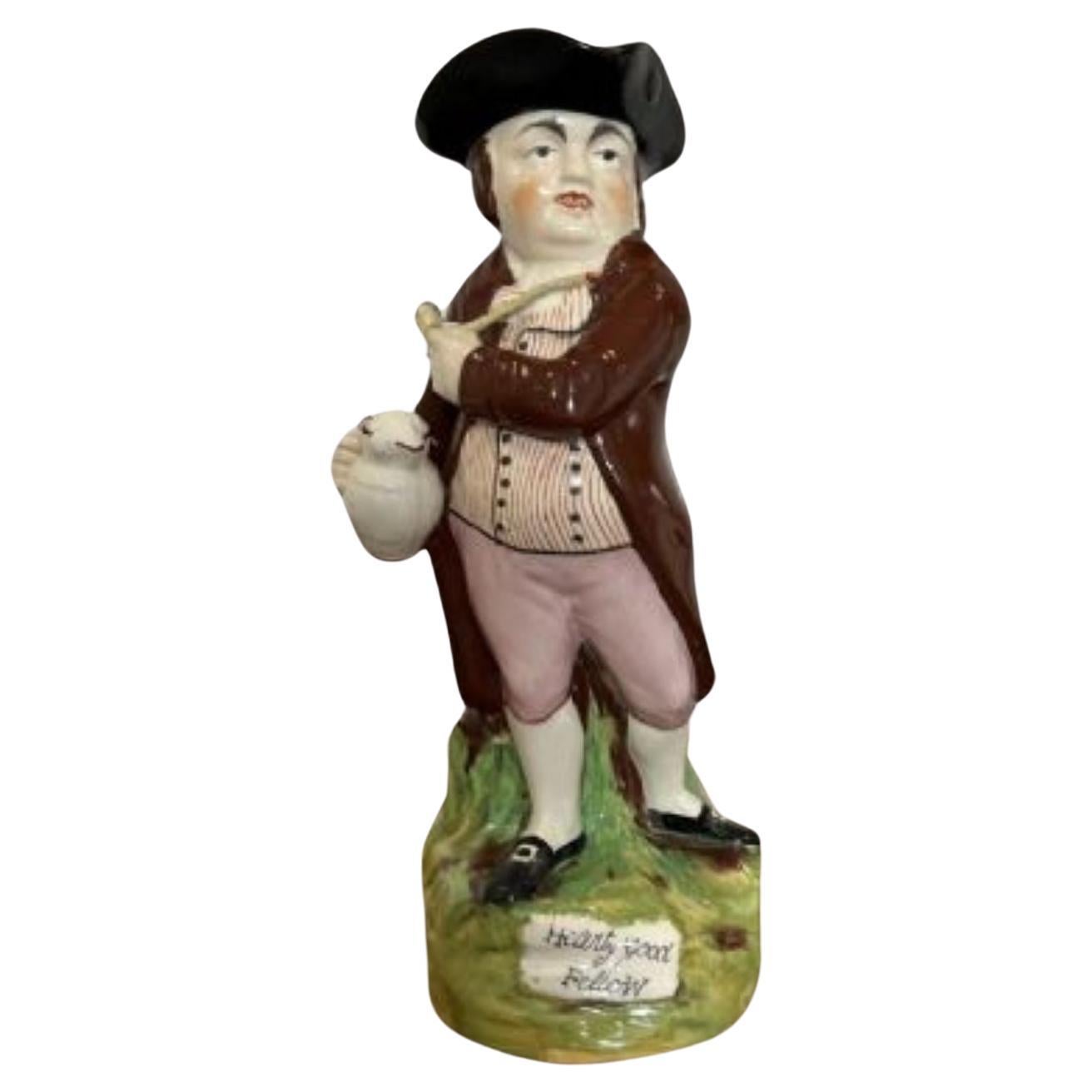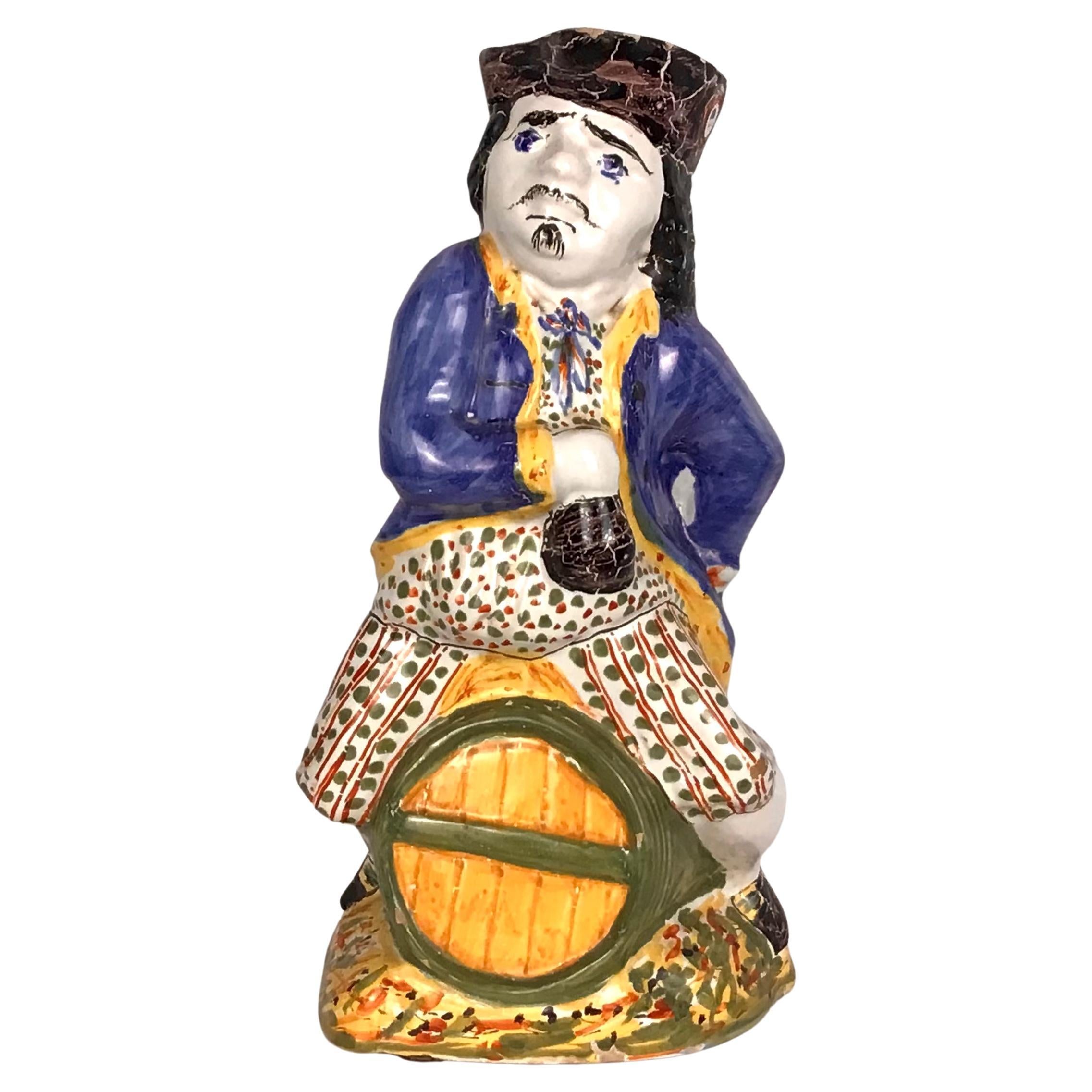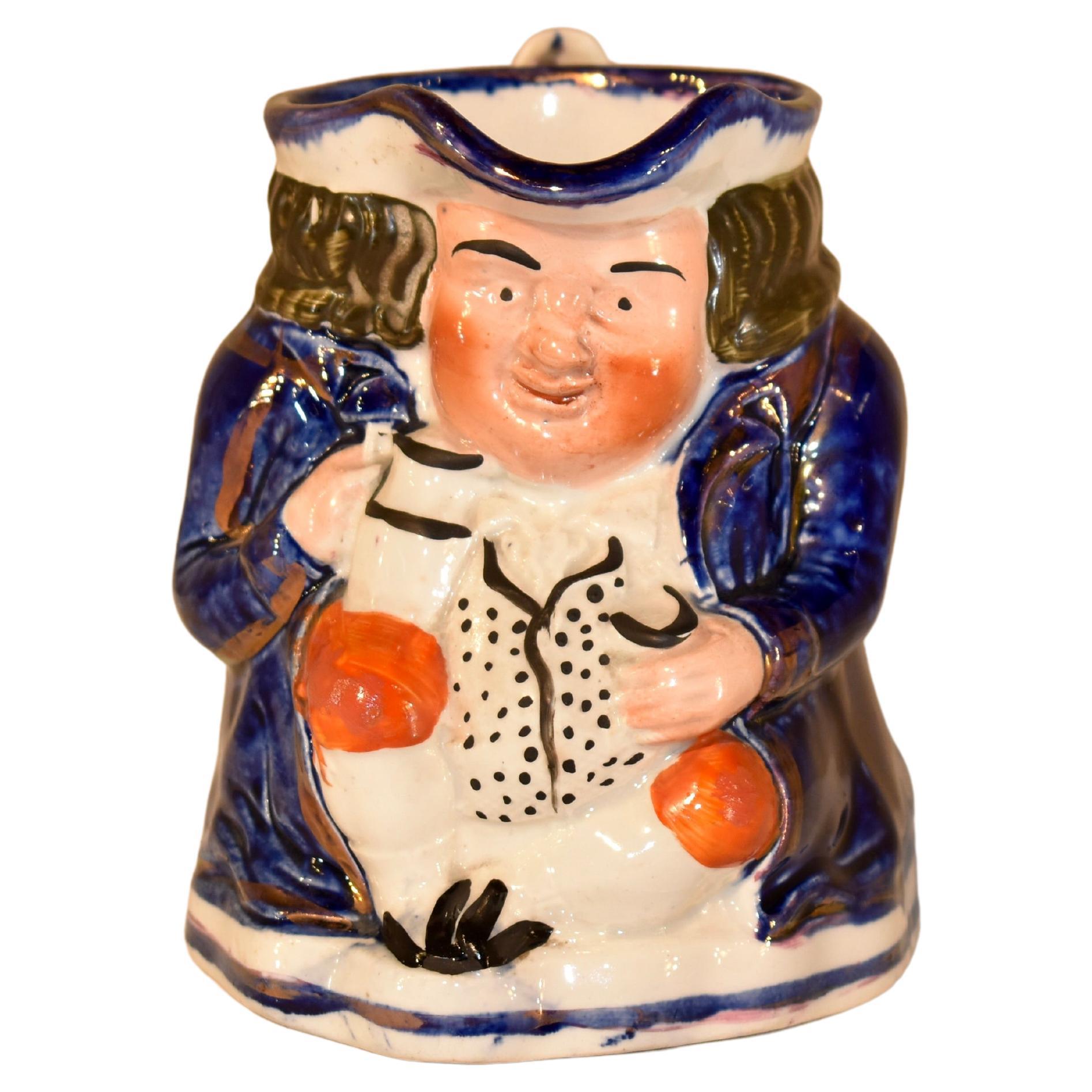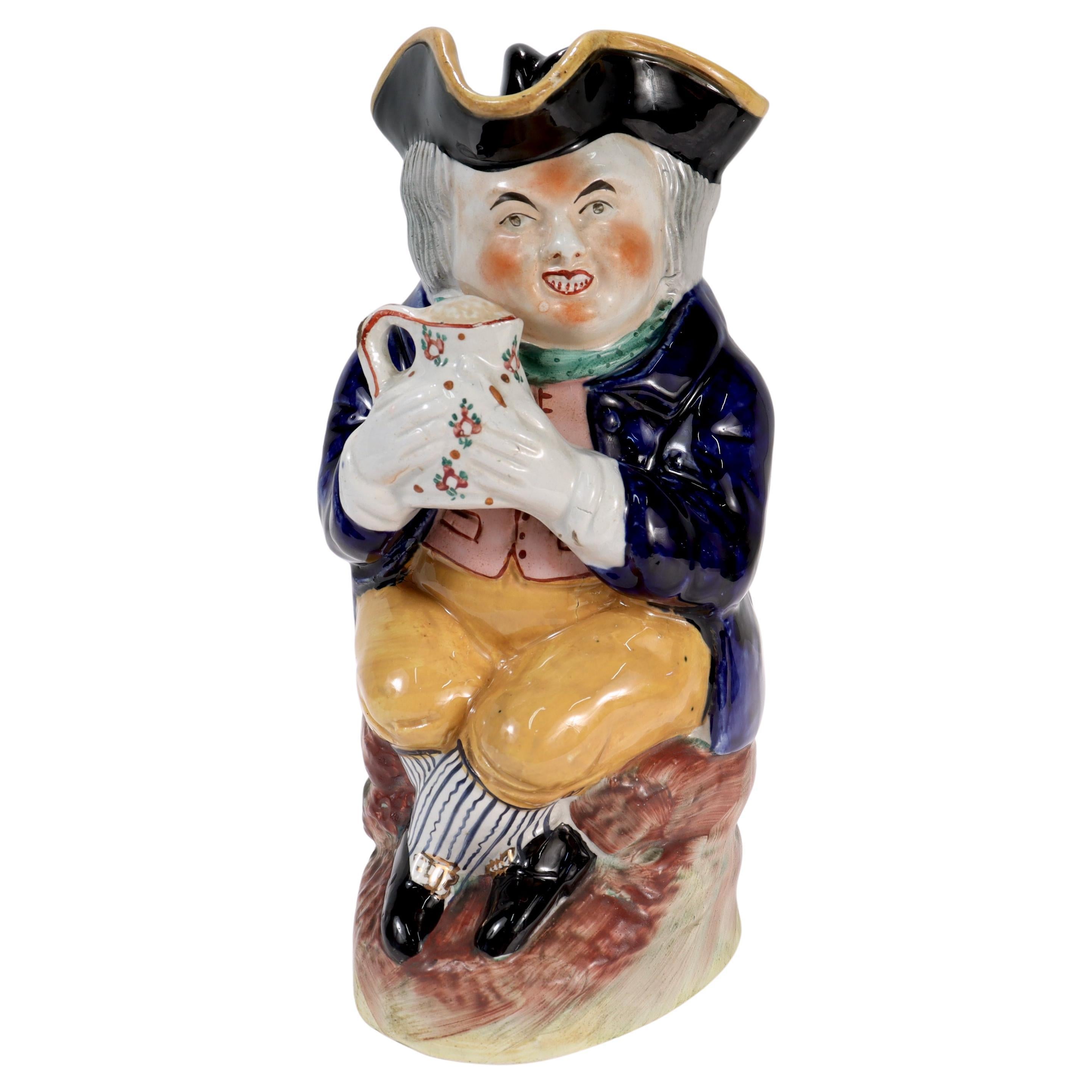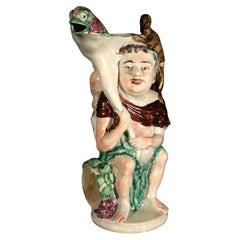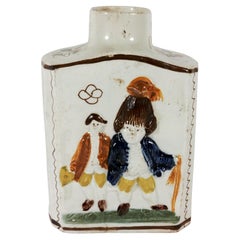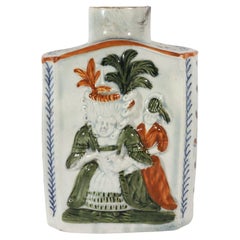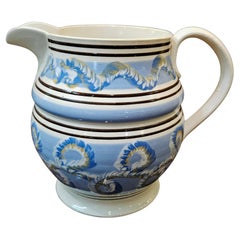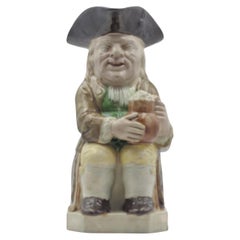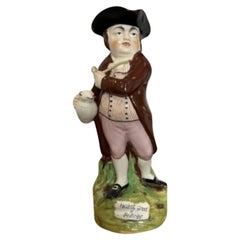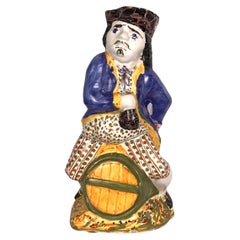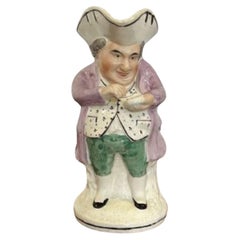Items Similar to 18th-Century English Pottery Hearty Good Fellow Toby Jug
Want more images or videos?
Request additional images or videos from the seller
1 of 8
18th-Century English Pottery Hearty Good Fellow Toby Jug
$2,200
£1,670.20
€1,910.36
CA$3,073.72
A$3,418.65
CHF 1,785.11
MX$41,601.29
NOK 22,798.59
SEK 21,381.06
DKK 14,257.71
Shipping
Retrieving quote...The 1stDibs Promise:
Authenticity Guarantee,
Money-Back Guarantee,
24-Hour Cancellation
About the Item
English pottery hearty good fellow pearlware toby jug
circa 1800
An unusual variation on the hearty good fellow standing toby jug, The base in white with the Toby figure standing, supporting a large white jug under his right arm, and holding a pipe with his left hand across his chest with his head turned slightly to the left. He has a bright blue jacket and yellow pantaloons with an orange waistcoat. He has a brown tricorn hat.
Dimensions: 9 1/4 inches high x 4 1/4 inches deep x 4 1/4 inches wide.
- Dimensions:Height: 9.25 in (23.5 cm)Width: 4.25 in (10.8 cm)Depth: 4.25 in (10.8 cm)
- Style:Georgian (Of the Period)
- Materials and Techniques:
- Place of Origin:
- Period:
- Date of Manufacture:1790-1800
- Condition:Wear consistent with age and use.
- Seller Location:Downingtown, PA
- Reference Number:Seller: NY9461-AARR1stDibs: LU861020688602
About the Seller
5.0
Recognized Seller
These prestigious sellers are industry leaders and represent the highest echelon for item quality and design.
Platinum Seller
Premium sellers with a 4.7+ rating and 24-hour response times
Established in 1916
1stDibs seller since 2009
414 sales on 1stDibs
Typical response time: 1 hour
Associations
The Art and Antique Dealers League of AmericaAntiques Associations Members
- ShippingRetrieving quote...Shipping from: Downingtown, PA
- Return Policy
Authenticity Guarantee
In the unlikely event there’s an issue with an item’s authenticity, contact us within 1 year for a full refund. DetailsMoney-Back Guarantee
If your item is not as described, is damaged in transit, or does not arrive, contact us within 7 days for a full refund. Details24-Hour Cancellation
You have a 24-hour grace period in which to reconsider your purchase, with no questions asked.Vetted Professional Sellers
Our world-class sellers must adhere to strict standards for service and quality, maintaining the integrity of our listings.Price-Match Guarantee
If you find that a seller listed the same item for a lower price elsewhere, we’ll match it.Trusted Global Delivery
Our best-in-class carrier network provides specialized shipping options worldwide, including custom delivery.More From This Seller
View AllEnglish Staffordshire Pearlware Pottery Large Bacchus Jug
By Staffordshire
Located in Downingtown, PA
English Pearlware Pottery Large Bacchus Jug,
Staffordshire,
Circa 1800
The Pearlware pottery large jug depicts Bacchus sitting on a barrel holding a large cornucopia on his right sh...
Category
Antique Late 18th Century English Georgian Pottery
Materials
Pearlware, Pottery
Prattware Pottery Pearlware Tea Canister, Macaroni Figures
Located in Downingtown, PA
Prattware English Pottery Pearlware Tea Canister,
Macaroni Figures,
Possibly Bankfoot Pottery, Prestonpans. Scotland,
Circa 1790-1800.
The pearlware pottery tea caddy is decorated with "Macaroni" figures. On one side is depicted a gentleman wearing an exaggeratedly high wig with his servant standing beside him. On the other side is a similarly caricatured lady and her servant.
The caddy was possibly made in Scotland at Prestonpans where plaster of Paris moulds were recovered during excavations. Plaster of Paris moulds recovered during excavations below the floor of the Belfield Pottery in Prestonpans and almost certainly dumped from the earlier Bankfoot pottery.
Dimensions: 5 1/8 inches high x 3-1/4 inches wide x 2 inches deep.
Condition: Good with a small firing line to the foot-see photo.
The figures depicted on the tea caddy are modelled in very full relief and painted in green and brown. The narrow sides of the tea caddy are painted with a flowering vine. In the canted corners of the caddy is a stylized underglaze blue leaf.
During the 18th century, "macaroni" was the satirical term for men who sported elaborate clothing and continental affectations. Lampooning various occupations and specific styles, these are reproductions of period cartoons.
These amusing figures are after English caricatures produced between 1765 and 1790. The satirical jibes were directed at the young moderns of the time, known as "macaronies."
A group of privileged young Englishmen adopted styles and manners they had admired during their travels in Italy and France. They formed the Macaroni Club (macaroni being virtually unknown in England at the time), an eating club where they vied with one another in matters of dress and manners. Extremes developed and soon spread into larger society. With ribbon-and-lace festooned clothing, prim-verging-on-prissy manners and absurd coiffures, macaronies (both male and female) were subjects of ridicule.
Provenance: Private Maine Collection
Reference:
Haggarty, G 2010 ‘The Belfield Pottery Production Site Ceramic Resource Disk: The Northern Ceramic Society Journal Vol 26 (2009-10), 142-3 + CD ROM.
Pratt Ware: English and Scottish Relief Decorated and Underglaze Coloured Earthenware, 1780-1840, John and Griselda Lewis, Page 234.
Earle: The Earle Collection of Early Staffordshire...
Category
Antique Early 19th Century Scottish Georgian Pottery
Materials
Pottery
Prattware Pottery Macaroni Tea Caddy, Possibly Prestonpans. Scotland
Located in Downingtown, PA
Prattware English Pottery Pearlware Tea Canister,
Macaroni Figures,
Possibly Bankfoot pottery, Prestonpans. Scotland or Staffordshire,
Circa 1790-1800.
The pearlware pottery tea caddy is decorated with Macaroni figures. On one side is depicted a gentleman wearing an exaggeratedly high wig with his servant standing beside him. On the other side is a similarly caricatured lady and her servant.
Dimensions: 5 inches High x 3-1/4 inches Wide x 2 inches Deep.
Condition: Glaze imperfection to neck.
The caddy was possibly made in Scotland at Prestonpans where plaster of Paris moulds were recovered during excavations.
Plaster of Paris moulds recovered during excavations below the floor of the Belfield Pottery in Prestonpans and almost certainly dumped from the earlier Bankfoot pottery.
The figures are modelled in very full relief and painted in green and brown. The narrow sides of the tea caddy are painted with a flowering vine. In the canted corners of the caddy is a wavy underglaze blue line.
During the 18th century, "macaroni" was the satirical term for men who sported elaborate clothing and continental affectations. Lampooning various occupations and specific styles, these are reproductions of period cartoons.
These amusing figures are after English caricatures produced between 1765 and 1790. The satirical jibes were directed at the young moderns of the time, known as "macaronies."
A group of privileged young Englishmen adopted styles and manners they had admired during their travels in Italy and France. They formed the Macaroni Club (macaroni being virtually unknown in England at the time), an eating club where they vied with one another in matters of dress and manners. Extremes developed and soon spread into larger society. With ribbon-and-lace festooned clothing, prim-verging-on-prissy manners and absurd coiffures, macaronies (both male and female) were subjects of ridicule.
Provenance: Private Maine Collection
Reference:
Haggarty, G 2010 ‘The Belfield Pottery Production Site Ceramic Resource Disk: The Northern Ceramic Society Journal Vol 26 (2009-10), 142-3 + CD ROM.
Pratt Ware: English and Scottish relief decorated and underglaze coloured earthenware, 1780-1840, John and Griselda Lewis, Page 234.
Earle: The Earle Collection of Early Staffordshire Pottery...
Category
Antique Early 19th Century Scottish Georgian Pottery
Materials
Pearlware, Pottery
English Mocha Pottery Pearlware Earthworm Jug
Located in Downingtown, PA
English Mocha Pottery Pearlware Earthworm Jug,
Circa 1800-20
The pearlware mocha jug has three bands of blue slip and four of a white ground with two red-brown lines. The blue slip...
Category
Antique Early 19th Century English Folk Art Ceramics
Materials
Pearlware, Pottery
Staffordshire Pottery Figure of Bacchus With Cup on a Wine Barrel
By Staffordshire
Located in Downingtown, PA
Staffordshire Pottery Figure of Bacchus With Cup on a Wine Barrel,
19th Century
The charming figure depicts the figure of Bacchus with a grape and leaf wreath around his head sittin...
Category
Antique Late 19th Century English Victorian Figurative Sculptures
Materials
Pottery
Proskau Faience Tromp L'oeil Jug in the Form of a Parrot, circa 1770
By Proskau
Located in Downingtown, PA
Proskau Faience Jug in the form of a Parrot,
circa 1770.
The tromp l"oeil tin-glazed earthenware jug is in the form of a parrot with a removable head...
Category
Antique Late 18th Century Georgian Pottery
Materials
Faience
You May Also Like
Georgian Toby Jug - Wood C1785
By Ralph Wood Pottery
Located in Melbourne, Victoria
A fine early toby jug, from the Wood family of potters. Traditional form, seated and holding a foaming jug of beer, dressed in clothing of the day.
Toby jugs originated in the mid 18th century in Staffordshire. The name perhaps comes from Sir Toby Belch in Twelfth night; although I think both the jug and Sir Toby got their names from the song "The Brown Jug...
Category
Antique Late 18th Century British George III Pottery
Materials
Pottery
Antique Victorian Staffordshire Toby Jug
Located in Ipswich, GB
Antique Victorian Staffordshire Toby Jug having a quality Victorian Staffordshire toby jug of a man in wonderful period clothing in red, pink, ...
Category
Antique Early 19th Century Victorian Ceramics
Materials
Ceramic
English Staffordshire Ceramic Toby Jug Figure
Located in Bradenton, FL
English Staffordshire ceramic Toby Jug figure with jug in right hand and sitting on a barrel. "Hearty Good Fellow" type with polychrome underglaze colors, de...
Category
Antique Late 19th Century English Folk Art Ceramics
Materials
Pottery
Quality Antique Victorian Staffordshire toby jug of Mr Snuff
Located in Ipswich, GB
Quality antique Victorian Staffordshire toby jug of Mr Snuff having a quality Victorian toby jug of Mr Snuff in wonderful period clothing in pu...
Category
Antique Early 19th Century Victorian Ceramics
Materials
Ceramic
19th Century Staffordshire Toby Jug
Located in High Point, NC
19th century ceramic Toby jug from the Staffordshire region of England. He has a blue jacket and a warm expression on his face. The jug has copper lustre accents as well for added ...
Category
Antique 19th Century English Victorian Pitchers
Materials
Ceramic
Antique English Staffordshire Pottery Toby Jug with Tricorn Hat Lid
By Staffordshire
Located in Philadelphia, PA
A fine antique Staffordshire pottery Toby Jug.
In the form of a seated, smiling man holding a jug.
The man's tricorn hat serves as a lid, and an inte...
Category
Antique 19th Century English Georgian Pitchers
Materials
Pottery
